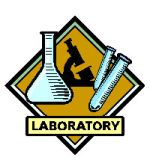| Page 4 |

|
|
1 - Chemical Safety
2 - Page 2 3 - Page 3 4 - Page 4 5 - Page 5 6 - Page 6 |

 HOME
HOMEChemical Storage

 |
![]() Chemical Storage in Quicktime Movie
Chemical Storage in Quicktime Movie
RunningTime: 10 minutes
Proper storage of laboratory chemicals means the storage of chemicals in such a manner as to prevent incompatible materials from being accidentally mixed together in the event of the breakage of one or more containers in the storage area or to prevent the formation of reactive vapors which may require vented chemical storage areas.
     |
Rules of thumb for safe storage
- Do not store more chemicals than you will need over a reasonable period.
- Always read the chemical's label and mark it with the date of receipt before storing.
- Never store highly reactive chemicals for longer than 6 months.
- Never store a chemical with an obscured or missing labels.
- Never store liquid hazardous chemicals above eye level.
- Store only cleaning materials directly under sink.
- Store chemicals on shelves with raised edges.
- Store heavy chemical containers on lower shelves, not on the floor.
- Store chemicals that can ignite at room temperature in a flammable cabinet. If flammables require cold storage, store only in refrigerator approved for such use. Chemicals such as organics will require vented flammable cabinets
- Corrosive, toxic, flammable, and highly reactive chemicals should be near a laboratory chemical hood to encourage use of the hood when transferring chemicals.
- Acids should be stored in trays that will catch any spill and provide adequate segregation. Most acids are stored in chemically resistant acid cabinets.
- Separate chemicals into compatible groups and store alphabetically within the groups.
- Designate separate storage areas for highly toxic chemicals.
Below is a concise guide to the storage of most lab scale chemicals.
- Perchloric acid is separated from all other materials.
- Hydrofluoric acid is separated from all other materials.
- Concentrated nitric acid is separated from all other materials.
- Highly toxic materials (LD50 of 50 mg/kg or less) are stored separately.
- Carcinogenic chemicals are stored separately.
- Inorganic acids (except for 1, 2, 3 above) are stored separately.
- Bases are stored separately.
- Strong oxidizing agents are stored separately.
- Strong reducing agents are stored separately.
- Water reactive, pyrophoric and explosive materials are stored separately.
- Flammable organic materials (solvents, organic acids, organic reagents) are stored separately.
- Do not store chemicals alphabetically!! This automatically induces incompatible storage, the condition wherein if two or more chemicals were mixed together during the breakage of their containers, the result would be generation of heat, fire, explosion, evolution of a toxic gas, etc.
The easiest and most efficient way to separate chemicals by compatibility group is to use secondary containment:
- Place the chemicals to be stored separately in a heavy gague Nalgene (or similar plastic) tub. Plastic secondary containers must be compatible with the material being stored.
- Strong acids, especially perchloric, nitric and hdrofluoric are best stored in plastic containers designed to store strong mineral acids. These are available from lab equipment supply houses.
- Bottle-in-a-can type of containers are also acceptable as secondary containment.
- Small containers of compatible chemicals may be stored in a dessicator or other secure container. This is especially useful for highly toxic materials and carcinogens.
If you are uncertain of the hazardous characteristics of a particular chemical refer to the MSDS for that material. A good MSDS will not only describe the hazardous characteristics of the chemical, it will also list incompatible materials.
Side note:The LD50, or Lethal Dose 50, is the amount of a chemical which will cause 50% of a population of test animals to die when the chemical is administered.
| << Previous 1 2 3 [4] 5 6 Next >> |
